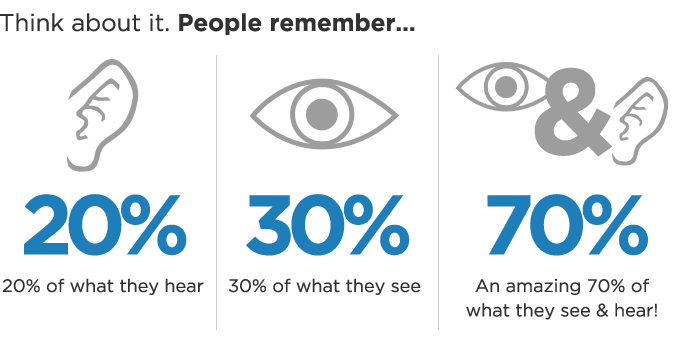In today's world, video marketing has become an essential tool for any business. It has the power to engage, entertain, and inform potential customers in a way that traditional marketing cannot. With the rise of social media platforms like Facebook, YouTube, and Instagram video marketing has become more accessible and more potent than ever before. Video marketing can help businesses of all sizes increase brand awareness, generate leads, and ultimately drive sales. In this post we will explore the benefits of video marketing, how to create a successful video marketing campaign, and tips on how to effectively use video marketing to unlock success for your business, if you're looking for a way to take your marketing to next level and stand out in a crowded market, then you won't want to miss this post.
1. Introduction: The rise of video marketing in the digital age
In today's digital age, video marketing has emerged as a powerful tool that has revolutionized the way businesses connect with their target audience. With the increasing popularity of online platforms and the widespread use of smartphones, videos have become a dominant form of content consumption. From captivating storytelling to engaging visuals, video marketing has the ability to captivate and resonate with viewers in a way that traditional marketing methods simply cannot.
The rise of video marketing can be attributed to various factors. Firstly, videos are incredibly versatile and can be tailored to suit different marketing goals such as brand awareness, lead generation, or product promotion. Whether it's a short and snappy social media video or a longer, more detailed explainer video, businesses have the flexibility to convey their message effectively.
Furthermore, videos have the unique ability to evoke emotions and create a memorable connection with the audience. By incorporating captivating visuals, music, and storytelling techniques, brands can leave a lasting impression on viewers, making them more likely to remember and engage with their content.
Additionally, the accessibility and shareability of videos on various platforms have contributed to their widespread success. With just a few clicks, videos can be shared across social media channels, reaching a wider audience and potentially going viral. This organic reach can significantly boost brand exposure and attract new customers.
Moreover, video marketing provides businesses with valuable insights into viewer behavior and engagement. Analytics tools allow marketers to track metrics such as views, likes, shares, and comments, providing valuable data that can be used to refine and optimize future video campaigns.
In conclusion, the rise of video marketing in the digital age has transformed the way businesses communicate and engage with their audience. Its versatility, emotional impact, and shareability have made it an essential tool in any successful marketing strategy. As technology continues to advance, embracing video marketing is no longer an option but a necessity for businesses aiming to unlock their full potential and thrive in the competitive digital landscape.
2. Understanding the impact of video marketing on consumer behavior
Video marketing has emerged as a powerful tool that can significantly impact consumer behavior. In today's fast-paced digital landscape, where attention spans are shrinking, videos have proven to be an effective medium for capturing and retaining the attention of potential customers.
One key reason for the impact of video marketing on consumer behavior is its ability to evoke emotions. Unlike text-based content, videos have the power to convey a message in a more engaging and compelling manner, leveraging visual and auditory elements to create a multi-sensory experience. This emotional connection can leave a lasting impression on viewers, influencing their purchasing decisions and brand loyalty.
Furthermore, videos have the ability to simplify complex information and communicate it more effectively. Whether it's demonstrating the features and benefits of a product or explaining a concept, videos can break down information into bite-sized, easily digestible chunks. This not only helps consumers better understand a product or service but also builds trust and credibility for the brand.
Another aspect that makes video marketing impactful is its shareability. Social media platforms have become a breeding ground for video content, with users actively sharing and consuming videos on a daily basis. By creating compelling and shareable videos, businesses can tap into the viral nature of social media, reaching a wider audience and generating organic exposure for their brand.
Moreover, videos have the ability to enhance brand storytelling. By incorporating visuals, music, and narration, businesses can create a narrative that resonates with their target audience on a deeper level. This storytelling approach humanizes the brand, establishing an emotional connection with consumers and fostering brand affinity.
In conclusion, understanding the impact of video marketing on consumer behavior is crucial in unlocking success. By leveraging the emotional appeal, ability to simplify information, shareability, and brand storytelling capabilities of videos, businesses can effectively engage with their audience, influence their behavior, and ultimately drive sales and growth.
3. Benefits of video marketing for businesses
Video marketing has emerged as a powerful tool for businesses of all sizes, offering a wide range of benefits. In today's digital age, where attention spans are shorter than ever, video content has the ability to captivate and engage audiences like no other medium.
First and foremost, video marketing is incredibly effective in conveying your brand message. It allows you to showcase your products or services in action, giving potential customers a tangible demonstration of what you have to offer. By visually demonstrating the features and benefits of your offerings, you can build trust and credibility with your audience, ultimately increasing the likelihood of conversions.
Furthermore, videos have the unique ability to evoke emotions and create memorable experiences. Through storytelling and visual elements, you can connect with your target audience on a deeper level, forging a strong emotional bond that encourages brand loyalty. Whether it's through inspirational stories, humorous skits, or heartfelt testimonials, videos have the power to leave a lasting impact on viewers.
Another key advantage of video marketing is its versatility and accessibility. With the prevalence of smartphones and social media platforms, videos can be easily shared and consumed across various channels. This opens up endless opportunities to reach a wider audience and increase your brand's visibility. Whether it's through YouTube, Instagram, Facebook, or even embedding videos in your website or email campaigns, you can leverage the power of video to connect with your target market wherever they may be.
Additionally, video marketing provides valuable insights into consumer behavior and engagement. With the help of analytics tools, you can track metrics such as views, engagement rates, and click-through rates, allowing you to measure the effectiveness of your video campaigns. This data-driven approach enables you to make informed decisions and optimize your marketing strategies for better results.
In conclusion, video marketing offers a multitude of benefits for businesses. From enhancing brand awareness and driving conversions to creating emotional connections and gaining valuable insights, incorporating video into your marketing efforts can unlock new levels of success. Embrace the power of video and harness its potential to elevate your brand and drive meaningful results.
4. How to create compelling video content that resonates with your audience
Creating compelling video content that resonates with your audience is key to unlocking success in video marketing. With the rise of video consumption across various platforms, it's essential to captivate your viewers and leave a lasting impression. Here are some tips to help you create engaging videos:
1. Know your audience: Before diving into video production, take the time to understand your target audience. What are their interests, pain points, and preferences? Tailor your content to address their needs and create a connection with them.
2. Tell a story: Storytelling is a powerful tool in video marketing. Craft a narrative that captures your audience's attention and keeps them engaged from beginning to end. Whether it's sharing customer success stories, showcasing product demonstrations, or taking viewers behind the scenes, a compelling story can leave a lasting impact.
3. Keep it concise: In today's fast-paced world, attention spans are shorter than ever. Aim for concise videos that deliver your message efficiently. Focus on the most important points and avoid unnecessary fluff. A shorter, well-paced video is more likely to hold your audience's attention.
4. Show, don't just tell: Video is a visual medium, so take advantage of it. Use visuals, graphics, and animations to enhance your message. Demonstrating your product or service in action can be more powerful than simply describing it. Use compelling visuals that align with your brand and leave a lasting impression.
5. Engage with emotions: Emotions are a driving force behind human behavior. Tap into your audience's emotions by creating videos that evoke feelings such as joy, excitement, empathy, or even nostalgia. Emotionally resonant videos are more likely to be shared and generate a strong connection with your audience.
6. Optimize for different platforms: Different platforms have varying video requirements and viewing behaviors. Optimize your video content for each platform to ensure it is displayed and experienced effectively. Consider factors such as video length, format, and orientation to maximize reach and engagement.
7. Call to action: End your video with a clear call to action that prompts viewers to take the desired next step. Whether it's subscribing to your channel, visiting your website, or making a purchase, guide your audience towards the intended action and make it easy for them to follow through.
By implementing these strategies, you can create compelling video content that resonates with your audience and drives success in your video marketing efforts. Remember to continuously analyze and adapt your approach based on audience feedback and metrics to optimize your videos for maximum impact.
5. Choosing the right platforms to distribute your videos
Choosing the right platforms to distribute your videos is crucial in maximizing their impact and reaching your target audience effectively. With the vast number of platforms available, it can be overwhelming to decide where to invest your time and resources. However, understanding the strengths and demographics of each platform can help you make informed decisions.
YouTube, with over 2 billion monthly active users, is a powerhouse when it comes to video content. It offers a wide reach, making it ideal for increasing brand visibility and gaining new followers. Its search functionality also allows users to discover your videos organically, making it a valuable platform for long-term exposure.
Facebook, with its massive user base of more than 2.8 billion monthly active users, offers great potential for video marketing. Its algorithm prioritizes video content, resulting in higher visibility and engagement. The platform's targeting options allow you to reach specific demographics, making it an excellent choice for targeting niche audiences.
Instagram, with its visually-driven format, is perfect for showcasing products, behind-the-scenes footage, and creative content. With over a billion monthly active users, it offers immense potential for engagement and brand building. Instagram Stories and IGTV provide additional avenues for sharing videos and connecting with your audience in a more immersive way.
LinkedIn, although primarily known as a professional networking platform, has been steadily growing as a video-sharing platform. It is a great platform for B2B marketing, where you can share educational and industry-specific videos to establish thought leadership and engage with professionals in your field.
Snapchat, with its focus on ephemeral content, is popular among younger demographics. It offers unique advertising options, such as branded filters and lenses, allowing you to create interactive and memorable video campaigns.
TikTok, the rapidly growing platform known for its short-form videos, has gained incredible popularity among Gen Z and millennial audiences. Its algorithm-driven content discovery makes it a fertile ground for viral video marketing and reaching a younger demographic.
Ultimately, the choice of platforms should align with your target audience and marketing objectives. By carefully selecting the right platforms, you can ensure that your videos are reaching the right people, generating engagement, and driving the desired results for your business.
6. Strategies for promoting and optimizing your video marketing campaigns
Promoting and optimizing your video marketing campaigns is crucial to unlocking success in the digital landscape. Here are some effective strategies that can help you maximize the reach and impact of your video content:
1. Utilize social media platforms: Share your videos across various social media channels such as Facebook, Instagram, Twitter, and LinkedIn. Each platform has its own unique features and audience demographics, so tailor your content accordingly. Encourage engagement by asking viewers to like, comment, and share your videos, which can help amplify your reach.
2. Optimize for search engines: Just like any other form of content, optimize your videos for search engines to improve visibility. Use relevant keywords in your video titles, descriptions, and tags. Additionally, create a compelling thumbnail image that entices viewers to click and watch your video.
3. Embed videos on your website: Leverage the power of your website by embedding your videos on relevant landing pages or blog posts. This not only enhances user experience but also increases the chances of your videos being discovered by visitors to your site.
4. Collaborate with influencers: Identify influencers in your industry or niche who have a large following and align with your brand values. Collaborate with them to create engaging video content that resonates with their audience. This can significantly expand your reach and expose your brand to a new set of potential customers.
5. Leverage email marketing: Harness the power of your email list by including video content in your newsletters or dedicated email campaigns. Visuals can capture attention and drive higher engagement rates, ultimately leading to increased conversions.
6. Analyze and optimize: Track the performance of your video campaigns using analytics tools to gain insights into user behavior, engagement, and conversion rates. Use this data to refine your video marketing strategies, experiment with different formats and styles, and continuously improve your content.
Remember, the key to successful video marketing is to consistently produce high-quality, relevant, and engaging content that resonates with your target audience. By implementing these strategies, you can effectively promote and optimize your video campaigns, driving greater brand awareness, engagement, and ultimately, business success.
7. Case studies: Real-life examples of successful video marketing campaigns
Case studies provide valuable insights into the effectiveness and impact of video marketing campaigns. By examining real-life examples of successful campaigns, businesses can gain inspiration and learn from the strategies employed by others. These case studies not only showcase the power of video marketing but also offer practical tips and techniques to implement in your own campaigns.
One such case study is the viral video campaign launched by a popular fast-food chain. The company created a series of short, entertaining videos featuring humorous scenarios related to their products. These videos quickly gained traction on social media platforms, generating millions of views and shares within a short span of time. As a result, the brand experienced a significant increase in brand awareness and customer engagement.
Another noteworthy case study revolves around a fitness app that utilized video marketing to promote its services. The company produced a series of workout videos featuring professional trainers and fitness enthusiasts. These videos not only provided valuable fitness tips but also showcased the app's features and benefits. By distributing these videos across various online platforms, the app successfully attracted a large number of new users and generated a surge in app downloads.
These case studies highlight the effectiveness of video marketing in capturing audience attention, driving engagement, and ultimately boosting business success. They demonstrate the potential of videos to tell compelling stories, evoke emotions, and create memorable experiences for viewers. By studying these successful campaigns, businesses can gain insights into effective video marketing strategies, such as storytelling, humor, and showcasing the unique value proposition of their products or services.
In conclusion, case studies serve as powerful tools to unlock the potential of video marketing. With numerous real-life examples of successful campaigns, businesses can learn from the experiences of others and apply these insights to their own video marketing efforts. By harnessing the power of videos, businesses can effectively engage their target audience, build brand awareness, and ultimately drive success in today's digital landscape.
8. Measuring the success of your video marketing efforts
Measuring the success of your video marketing efforts is crucial for understanding the impact of your campaigns and making informed decisions to drive future success. Fortunately, the digital landscape offers a variety of metrics and tools that can help you gauge the effectiveness of your videos.
One key metric to consider is the view count, which indicates how many times your video has been watched. While a high view count can be an encouraging sign, it doesn't necessarily guarantee success. You should also assess the engagement metrics, such as likes, comments, and shares. These metrics demonstrate how well your video resonates with your audience and sparks meaningful interactions.
Another essential metric is the watch time or retention rate. This shows how long viewers are staying engaged with your video content. A high retention rate suggests that your video is captivating and holds the attention of your audience. On the other hand, a significant drop-off in watch time might indicate that certain aspects of your video need improvement.
Furthermore, tracking conversions is vital to determine the impact of your video marketing on your business's bottom line. Whether it's driving sales, generating leads, or increasing website traffic, monitoring conversions can provide valuable insights into the effectiveness of your video campaigns.
To measure these metrics effectively, you can utilize various analytics tools provided by platforms like YouTube, Facebook, or Vimeo. These tools offer detailed analytics reports that allow you to analyze performance and make data-driven decisions for optimizing future video marketing strategies.
Remember, the key to unlocking success with video marketing lies in regularly monitoring and evaluating these metrics. By understanding what resonates with your audience and continuously refining your approach, you can maximize the impact of your video marketing efforts and achieve your business goals.
9. Overcoming common challenges in video marketing
Video marketing can be a powerful tool for businesses, but it is not without its challenges. In this section, we will explore some of the common obstacles that companies face in their video marketing efforts and provide strategies to overcome them.
One of the most prevalent challenges is creating engaging and high-quality video content. Many businesses struggle with finding the right balance between informative and entertaining videos that capture the attention of their target audience. To overcome this challenge, it is essential to invest in professional equipment, such as cameras and lighting, and work with experienced videographers or video production companies. Additionally, conducting thorough research on your target audience's preferences and interests can help ensure that your video content resonates with them.
Another challenge in video marketing is distribution and reaching a wide audience. With the abundance of online platforms and social media channels, it can be overwhelming to determine the best platforms to showcase your videos. To overcome this challenge, it is crucial to have a well-defined video distribution strategy. This may involve leveraging the power of popular platforms like YouTube, Facebook, Instagram, and LinkedIn, as well as utilizing your website and email marketing campaigns to share your videos with your existing audience.
Measuring the effectiveness of video marketing campaigns is another common challenge faced by businesses. Without proper tracking and analysis, it becomes difficult to assess the impact of your videos and make informed decisions for future campaigns. To overcome this challenge, it is important to set clear goals and key performance indicators (KPIs) for each video campaign. Utilizing analytics tools and video marketing platforms that provide detailed insights and metrics can help you track the performance of your videos, such as views, engagement, conversions, and return on investment (ROI).
Lastly, staying consistent with video production and maintaining a regular schedule can be a challenge for businesses. It requires time, effort, and creativity to consistently produce high-quality videos that align with your brand and engage your audience. To overcome this challenge, it is beneficial to create a content calendar and plan your video production in advance. This allows for better organization, ensures a steady flow of content, and helps maintain consistency in your video marketing efforts.
By acknowledging and addressing these common challenges, businesses can unlock the full potential of video marketing and drive their success. With the right strategies and a commitment to creating compelling video content, businesses can overcome these obstacles and achieve their marketing objectives.
10. Future trends and the evolving landscape of video marketing
As technology continues to advance at a rapid pace, video marketing is not only becoming increasingly prevalent but also evolving in exciting ways. In order to stay ahead of the curve and unlock success in your marketing efforts, it is crucial to be aware of the future trends and the evolving landscape of video marketing.
One such trend is the rise of live video streaming. With platforms like Facebook Live, Instagram Live, and YouTube Live gaining popularity, brands now have the opportunity to connect with their audience in real-time, providing an authentic and interactive experience. Live video allows for immediate engagement, enabling brands to answer questions, showcase products, and share behind-the-scenes moments, fostering a sense of transparency and building trust with their audience.
Another emerging trend is the use of virtual reality (VR) and augmented reality (AR) in video marketing. VR allows viewers to fully immerse themselves in a virtual world, while AR overlays digital information onto the real world. These technologies provide a unique and immersive experience for consumers, allowing brands to create innovative and memorable campaigns that leave a lasting impact.
Furthermore, personalized video marketing is gaining traction as brands recognize the power of customization and tailored messaging. By leveraging data and insights, marketers can create videos that resonate with individual viewers, increasing engagement and driving conversions. Personalized videos can be used throughout the customer journey, from personalized product recommendations to personalized thank-you messages, enhancing the overall customer experience.
In addition to these trends, the evolving landscape of video marketing also includes the growing importance of mobile optimization. With an increasing number of people consuming video content on their smartphones, it is crucial for brands to ensure their videos are optimized for mobile viewing. This includes creating shorter, attention-grabbing videos, utilizing captions for silent viewing, and optimizing video formats for different devices and platforms.
As video marketing continues to evolve, it is essential for brands to stay informed and adapt their strategies accordingly. By embracing future trends such as live video streaming, VR and AR, personalized video marketing, and mobile optimization, brands can unlock the full potential of video marketing and achieve unparalleled success in their marketing efforts.
We hope you found our blog post on the power of video marketing insightful and inspiring. Video marketing is an incredibly effective tool that can unlock success for your business. By incorporating engaging videos into your marketing strategy, you can captivate your audience, build brand awareness, and drive more conversions. Remember to focus on storytelling, authenticity, and providing value to your viewers. With the right approach and creativity, video marketing has the potential to take your business to new heights. So grab your camera, start brainstorming ideas, and unlock the power of video marketing for your brand today!
------------------------------







![What Is Social Media Marketing and why is it important ? with example [ For Beginners ]](https://blogger.googleusercontent.com/img/b/R29vZ2xl/AVvXsEgv9hpDOJtXVFDDK2ZP4TXHbDPVFujJCoa4NnO3EAgz6XOSvyJvpOfKEJN1L5oOg88ejpl7STVBx1xqgL9_VfSdh1nawc9rd7UIiNgDvg9HE9OqMOqhW3vcEGEkDpnMbhNTyQFjFxPDZvP5YCRawVFPDUYXStV7vp5VCyiBnBjEUEllw-iJrDYKWpqHGN0/w100/Social-Media-Marketing.jpg)

0 Comments